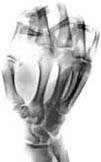
| Records | Reviews | Tracks | Concerts | Gallery |
Faust Breathe Life Into Nosferatu : live at The Royal Festival Hall, London, Wed October 25, 2000Tim CummingThe Guardian, 27 Oct 2000It was a marriage made in heaven (or perhaps hell): the Krautrock legends Faust and FW Murnau's classic silent horror movie Nosferatu, made in 1921. Drawing on music from their 1997 album, Faust Wakes Nosferatu, which was itself inspired by the film, Faust accompanied a screening of the movie with an enthralling, apocalyptic river of sound. The audience was more Faustian than silver-screen. Indeed, a number of Nosferatu purists soon abandoned their seats in horror. Even Faust's fans seemed uncertain of what to expect from a band that uses anything from wind machines to paint-daubed nudity in live performances. The stage set-up directly under the screen included a thunder sheet and brazier alongside drums and guitars, all draped in spider's webs. The band took to the stage casually and began playing some 10 minutes before the film began. Though the audience initially focused more on Faust than on the film, the movie's extraordinary, powerful imagery soon took hold. Max Schreck's rat-like Nosferatu is one of cinema's most powerful icons, rising flat-packed from his coffin, looming in distorted, Gothic doorways, but Faust matched his intensity. In an unbroken two-hour performance, they delivered an uncompromising, powerful sonic attack that rose and fell, ebbed and pulsed to evoke in heady, abstract music the power of Murnau's primal, poetic imagery. The piece of music perfectly matched Murnau's primitive expressionism. The director absorbed Max Rheinhardt's expressionist ideas early on in his career, and Nosferatu achieves its haunting effects through classic distortions of lighting, staging, and brilliant, imagistic editing. Tracking the film's dream-like, nightmarish qualities, Faust's uncompromising battery of sound was pure 1970s kosmische freakout heaven, yet in a resolutely contemporary performance. Faust are no museum piece or retro act, and Nosferatu is as timeless as anything in cinema history. As the band felt their way instinctively through the film with a choreographed progression of dirty electronics, flute, cello, distorted guitars, percussion and the kind of arc-welding equipment you can find at any tool hire shop, the sparks literally flew. The music and film reached a kind of mutual climax as Nosferatu rose up at the heroine's bedroom window in the last reel, awaiting her submission to his spell. It was a wonderful moment. Tim Cumming, "Faust Breathe Life Into Nosferatu", The Guardian 2000 |
|